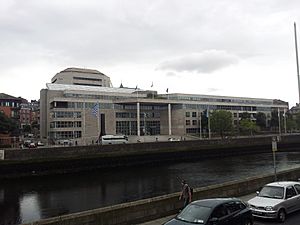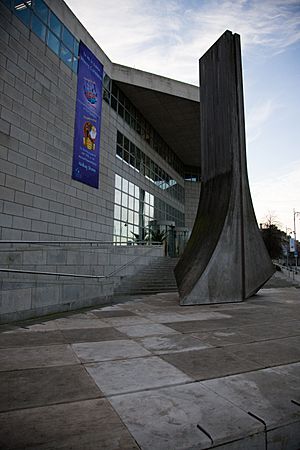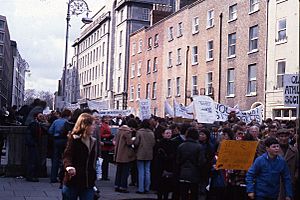Wood Quay facts for kids
| Cé Adhmaid | |

Dublin City Council buildings on Wood Quay
|
|
| Namesake | was originally surfaced with wood |
|---|---|
| Length | 130 m (430 ft) |
| Width | 30 metres (98 ft) |
| Location | Dublin, Ireland |
| Postal code | D08 |
| Coordinates | 53°20′42″N 6°16′16″W / 53.345°N 6.271°W |
| west end | Merchant's Quay, Winetavern Street, O'Donovan Rossa Bridge |
| east end | Fishamble Street, Essex Quay |
| Construction | |
| Construction start | medieval |
| Other | |
| Known for | Dublin City Council offices, archaeological remains |
Wood Quay (Irish: An Ché Adhmaid) is a special riverside area in Dublin, Ireland. Long ago, it was a settlement for the Vikings. Today, the main offices for the Dublin City Council are located here.

Contents
Where is Wood Quay?
Wood Quay is located along the River Liffey in Dublin. To the north, it faces the river. To the west, you'll find Winetavern Street. John's Lane is to the south, and Fishamble Street is to the east.
Two bridges cross the river at Wood Quay. Grattan Bridge is at the eastern end. It used to be called Essex Bridge. O'Donovan Rossa Bridge is at the western end. It is named after a 19th-century Irish nationalist.
The Story of Wood Quay
Plans for New Buildings
The city government, then called Dublin Corporation, started buying land at Wood Quay in the 1950s. They wanted to build new offices there. The land was about 4 acres, right in front of Christchurch Cathedral.
Their first building design would have blocked the view of the cathedral. Many people, including architects, did not like this plan. So, the design was changed. By 1967, the Corporation owned all the land. Old buildings were torn down, including a pub.
The Corporation then held a competition for new building designs. In 1968, they showed the models from six finalists. Many people thought the designs were not good. There was concern that architects were not involved in choosing the winner.
Finally, a group of 12 experts was chosen to pick the best design. The winning design came from Sam Stephenson. It included four office blocks, ranging from 5 to 10 stories tall.
Building Approval and Concerns
The plans for the new offices needed official approval. Two city departments initially rejected the plans. However, the city manager, Matt Macken, approved them in December 1970.
More than 30 groups and people objected to the plans. This included the National Monuments Advisory Council. They were worried about what might be found underground. An official meeting was held in March 1971. The minister, Bobby Molloy, finally approved the plans in July 1972. This approval came with 15 conditions. One important condition was that archaeologists must be allowed to explore the site. They needed to "inspect, record and recover matter of archaeological interest."
Discovering Ancient History
Large archaeological digs took place at Wood Quay from 1973 to 1981. These digs were led by Pat Wallace from the National Museum of Ireland. They covered 4 acres of land.
Archaeologists found about 100 ancient homes and thousands of objects. They also found many clues about the environment. These discoveries showed how people lived there for 500 years in medieval times. The area was a busy trading center. It was a mix of Viking and Irish cultures, sometimes called "Hiberno-Norse." This confirmed Wood Quay was one of Dublin's oldest settled areas.
Protecting the Past
The archaeological work faced challenges. In May 1973, bulldozers damaged parts of the site. They even destroyed a newly found section of the old city wall. In November 1973, the government ordered a stop to the work.
Many people were happy about this. Some suggested making an archaeological park instead of offices. However, the site was steep and not ideal for a public park. During this pause, the Corporation looked at other places to build. But these were all rejected.
It was then suggested that the four office blocks be moved on the site. This would allow a clear view of Christchurch Cathedral. In February 1974, the government announced the project would go ahead. The office block was moved to the Fishamble Street side. Some groups, like An Taisce, felt this was the "worst possible solution." They believed the modern offices would not fit well with the historic cathedral.
The amazing finds at Wood Quay led to a big public effort to stop the building. Professor F. X. Martin led this campaign. He was the head of the Friends of Medieval Dublin. On September 23, 1978, about 20,000 people marched in a protest called "Save Wood Quay."
In June 1979, 52 people started a three-week sit-in at the site. This was called "Operation Sitric." Famous people like architect Michael Scott and writer Mary Lavin joined them. Over 80 groups, including the Council of Europe, asked for the site to be saved.
The Irish High Court said the site was a National Monument. However, the city government continued with the building plans. The protests and legal battles meant the archaeological digs lasted longer than planned. This extra time allowed for more discoveries.
What We Learned
Today, many items found at Wood Quay are on display at the National Museum of Ireland. The soil conditions at the site were special. They kept organic materials, especially wood, very well preserved. This is why so many objects were found.
The objects show that people traded farm goods and luxury items like combs and jewelry. The archaeological work finished in March 1981. Most of Wood Quay is now home to Dublin City Council's Civic Offices, which opened in 1986.
Even though the site was not fully preserved, the Wood Quay protests were important. They showed that Ireland needed better laws to protect historical sites. New laws have been put in place since then.
See also
 In Spanish: Wood Quay para niños
In Spanish: Wood Quay para niños



